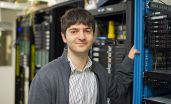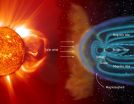(Press-News.org) Research led by the Teichmann group on the Wellcome Genome Campus has identified a fundamental mechanism for controlling protein function. Published in the journal Science, the discovery has wide-ranging implications for biotechnology and medicine.
The shape of a protein determines its function, for example whether it is able to interact with another protein or with a drug. But a protein's shape is not constant - it may change in response to different conditions, or simply as a matter of course.
Understanding how this process works is key to figuring out how to manipulate proteins, for example in order to disrupt a disease. Today's finding provides important clues that will help focus future research.
The team looked at a family of bacterial RNA-binding proteins that control a basic process in metabolism: one type of bacteria lives in very high temperatures, and the other likes things colder. The goal was to determine how a protein morphs from an active configuration (one that lets it bind to RNA) to an inactive one in two very different environments.
"The process is controlled by mutations, but these mutations aren't in an obvious place, where the binding happens," explains Sarah Teichmann, research group leader at the European Bioinformatics Institute (EMBL-EBI) and the Wellcome Trust Sanger Institute. "They're actually working from a distance, indirectly, to change the shape of those sites. We wanted to know how that works at an atomic level."
Undertaken initially as a purely computational study, lead author Tina Perica stepped away from her laptop and into the lab, where she worked with others to fill in the picture with experiments in biophysics, and integrated structural biology to detail how these mutations work.
"Any stable protein will have a lot of constraints on its mutational pathways," says Tina. "These mutations have very few options - just like a person walking along a cliff will need to keep to a narrow path. But at the same time, proteins need enough wiggle room to be able to bind to things, like another protein or a drug. To find where the protein could provide that wiggle room, we retraced its steps millions of years into the past, and used a lot of different approaches to figure out what was happening."
"If you know how a species of bacteria has evolved, you can reconstruct proteins that it may have had in the past, but which don't exist today," says Yasushi Kondo from MRC Laboratory of Molecular Biology. "We made a couple of these proteins, and used X-ray crystallography to solve their structures. That let us see details we would never have seen if we'd only studied proteins from the bacteria that live today. When we put that new information together with computational work and simulations, we started to see a clear picture of how these proteins change."
"We were really pleased to do the elastic network modelling for this study, because it helps you see the dynamics of how the protein goes from one configuration to another," says Nathalie Reuters of the University of Bergen, Norway. "It also shows that these fluctuations are the same for natural mutations between the thermophilic and mesophilic organism, for allosteric ligands, for small molecules binding, or for engineered mutations."
"These proteins provide a very good example of a fundamental biophysical phenomenon that we think can happen in many proteins, regardless of which organism," says Sarah. "We believe our findings will help future research into manipulating proteins, which has potential applications across the life sciences."
INFORMATION:
University of Bergen video in English: http://vimeo.com/114662210
University of Bergen video in Norwegian: http://vimeo.com/114662134
Press release in Norwegian: http://www.uib.no/
In the decade since the genome was sequenced in 2003, scientists and doctors have struggled to answer an all-consuming question: Which DNA mutations cause disease?
A new computational technique developed at the University of Toronto may now be able to tell us.
A Canadian research team led by professor Brendan Frey has developed the first method for 'ranking' genetic mutations based on how living cells 'read' DNA, revealing how likely any given alteration is to cause disease. They used their method to discover unexpected genetic determinants of autism, hereditary cancers ...
The majority of RNA expression differences between individuals have no connection to the abundance of a corresponding protein, report scientists from the University of Chicago and Stanford University in Science on Dec. 18. The findings point to a yet-unidentified cellular mechanism that regulates gene expression and suggest studies that rely only on RNA measurements to characterize gene function require further analysis.
"The chief assumption for studies of RNA differences is that they ultimately reflect differences in an end product, which is protein," said senior study ...
HANOVER, N.H. - Human cells are protected by a largely impenetrable molecular membrane, but researchers have built the first artificial transporter protein that carries individual atoms across membranes, opening the possibility of engineering a new class of smart molecules with applications in fields as wide ranging as nanotechnology and medicine.
The study, which appears Friday, Dec. 19, in the journal Science, is a milestone in designing and understanding membrane proteins. A PDF is available upon request. The study was conducted by researchers from Dartmouth College, ...
A study of the way malaria parasites behave when they live in human red blood cells has revealed that they can rapidly change the proteins on the surface of their host cells during the course of a single infection in order to hide from the immune system.
The findings, which overturn previous thinking about the Plasmodium falciparum parasite's lifecycle, could explain why so many attempts to create an effective vaccine have failed and how the parasites are able to survive in the human body for such long periods of time.
In the study, Plasmodium falciparum parasites were ...
Scientists and engineers have built a computer model that has uncovered disease-causing mutations in large regions of the genome that previously could not be explored. Their method seeks out mutations that cause changes in 'gene splicing,' and has revealed unexpected genetic determinants of autism, colon cancer and spinal muscular atrophy.
CIFAR Senior Fellow Brendan Frey (University of Toronto) is the lead author on a paper describing this work, which appears in the Dec. 18 edition of Science Express. The paper was co-authored by CIFAR senior fellows Timothy Hughes (University ...
The evolution of trichromatic color vision in humans occurred by first switching from the ability to detect UV light to blue light (between 80-30 MYA) and then by adding green-sensitivity (between 45-30 MYA) to the preexisting red-sensitivity in the vertebrate ancestor. The detailed molecular and functional changes of the human color vision have been revealed by Shozo Yokoyama et al. Emory University and is published in the journal PLOS Genetics.
The molecular basis of functional differentiation is a fundamental question in biology. To fully appreciate how these changes ...
CAMBRIDGE, MA -- For decades, neuroscientists have been trying to design computer networks that can mimic visual skills such as recognizing objects, which the human brain does very accurately and quickly.
Until now, no computer model has been able to match the primate brain at visual object recognition during a brief glance. However, a new study from MIT neuroscientists has found that one of the latest generation of these so-called "deep neural networks" matches the primate brain.
Because these networks are based on neuroscientists' current understanding of how the ...
A University of Southampton researcher has helped solve a long standing space mystery - the origin of the 'theta aurora'.
Auroras are the most visible manifestation of the Sun's effect on Earth. They are seen as colourful displays in the night sky, known as the Northern or Southern Lights. They are caused by the solar wind, a stream of plasma - electrically charged atomic particles - carrying its own magnetic field, interacting with the earth's magnetic field.
Normally, the main region for this impressive display is the 'auroral oval', which lies at around 65-70 degrees ...
PROVIDENCE, R.I. - Where you live affects the type of bacteria that cause bloodstream infections, according to researchers at Rhode Island Hospital and an international team of investigators. The closer you live to the equator, the greater the likelihood of a bloodstream infection caused by a group of bacteria called Gram-negative bacteria, which thrive in warm and moist environments, compared to another group of bacteria referred to as Gram-positive bacteria. The study also found that the proportion of a country's GDP spent on health care impacted the type of bacteria ...
DALLAS - Dec. 18, 2014 - Retroviruses are best known for causing contagious scourges such as AIDS, or more sporadically, cancer.
But researchers at UT Southwestern Medical Center and Karolinska Institutet in Stockholm, Sweden, found that endogenous retroviruses (ERV) also play a critical role in the body's immune defense against common bacterial and viral pathogens.
"Most scientists have become used to the view that retroviruses are generally harmful," said Nobel Laureate Dr. Bruce Beutler, Professor and Director of UT Southwestern's Center for the Genetics of Host ...

